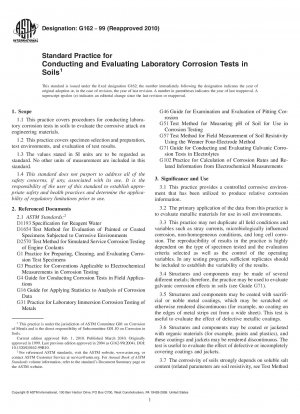ASTM G162-99(2010)
Standard Practice for Conducting and Evaluating Laboratory Corrosions Tests in Soils
- Standard No.
- ASTM G162-99(2010)
- Release Date
- 1999
- Published By
- American Society for Testing and Materials (ASTM)
- Status
- Replace By
- ASTM G162-18
- Latest
- ASTM G162-23
- Scope
This practice provides a controlled corrosive environment that has been utilized to produce relative corrosion information.
The primary application of the data from this practice is to evaluate metallic materials for use in soil environments.
This practice may not duplicate all field conditions and variables such as stray currents, microbiologically influenced corrosion, non-homogeneous conditions, and long cell corrosion. The reproducibility of results in the practice is highly dependent on the type of specimen tested and the evaluation criteria selected as well as the control of the operating variables. In any testing program, sufficient replicates should be included to establish the variability of the results.
Structures and components may be made of several different metals; therefore, the practice may be used to evaluate galvanic corrosion effects in soils (see Guide G71).
Structures and components may be coated with sacrificial or noble metal coatings, which may be scratched or otherwise rendered discontinuous (for example, no coating on the edges of metal strips cut from a wide sheet). This test is useful to evaluate the effect of defective metallic coatings.
Structures and components may be coated or jacketed with organic materials (for example, paints and plastics), and these coatings and jackets may be rendered discontinuous. The test is useful to evaluate the effect of defective or incompletely covering coatings and jackets.
The corrosivity of soils strongly depends on soluble salt content (related parameters are soil resistivity, see Test Method G57, and chemistry), acidity or alkalinity (measured by soil pH, see Test Method G51), and oxygen content (loose, for example, sand, or compact, for example, clay, soils are extreme examples). The manufacturer, supplier, or user, or combination thereof, should establish the nature of the expected soil environment(s) and select the test environment(s) accordingly. Multiple types of soil can be used to determine the effect of this variable.
1.1 This practice covers procedures for conducting laboratory corrosion tests in soils to evaluate the corrosive attack on engineering materials.
1.2 This practice covers specimen selection and preparation, test environments, and evaluation of test results.
1.3 The values stated in SI units are to be regarded as standard. No other units of measurement are included in this standard.
1.4 This standard does not purport to address all of the safety concerns, if any, associated with its use. It is the responsibility of the user of this standard to establish appropriate safety and health practices and determine the applicability of regulatory limitations prior to use.
ASTM G162-99(2010) Referenced Document
- ASTM D1193 Standard Specification for Reagent Water
- ASTM D1654 Standard Test Method for Evaluation of Painted or Coated Specimens Subjected to Corrosive Environments
- ASTM D2570 Standard Test Method for Simulated Service Corrosion Testing of Engine Coolants
- ASTM G1 Standard Practice for Preparing, Cleaning, and Evaluating Corrosion Test Specimens
- ASTM G102 Standard Practice for Calculation of Corrosion Rates and Related Information from Electrochemical Measurements
- ASTM G16 Standard Guide for Applying Statistics to Analysis of Corrosion Data
- ASTM G3 Standard Practice for Conventions Applicable to Electrochemical Measurements in Corrosion Testing
- ASTM G31 Standard Practice for Laboratory Immersion Corrosion Testing of Metals
- ASTM G4 Standard Guide for Conducting Corrosion Coupon Tests in Field Applications
- ASTM G46 Standard Guide for Examination and Evaluation of Pitting Corrosion*, 2018-10-01 Update
- ASTM G51 Standard Test Method for Measuring pH of Soil for Use in Corrosion Testing
- ASTM G57 Standard Test Method for Field Measurement of Soil Resistivity Using the Wenner Four-Electrode Method*, 2001-01-01 Update
- ASTM G71 Standard Guide for Conducting and Evaluating Galvanic Corrosion Tests in Electrolytes*, 2019-05-01 Update
ASTM G162-99(2010) history
- 2023 ASTM G162-23 Standard Practice for Conducting and Evaluating Laboratory Corrosion Tests in Soils
- 2018 ASTM G162-18 Standard Practice for Conducting and Evaluating Laboratory Corrosion Tests in Soils
- 1999 ASTM G162-99(2010) Standard Practice for Conducting and Evaluating Laboratory Corrosions Tests in Soils
- 1999 ASTM G162-99(2004) Standard Practice for Conducting and Evaluating Laboratory Corrosions Tests in Soils
- 1999 ASTM G162-99 Standard Practice for Conducting and Evaluating Laboratory Corrosions Tests in Soils
